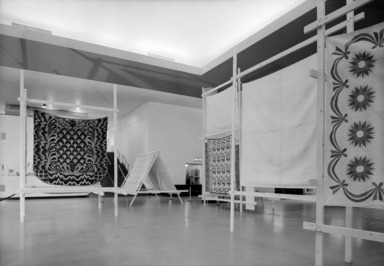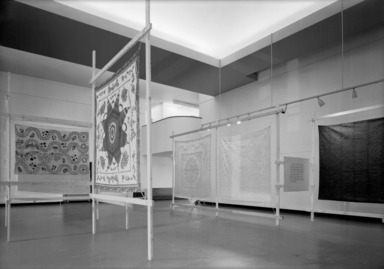

Quilts & Coverlets, June 28, 1960 through September 05, 1960 (Image: PHO_E1960i016_SL1.jpg Brooklyn Museum photograph, 1960)

Quilts & Coverlets, June 28, 1960 through September 05, 1960 (Image: PHO_E1960i017_SL1.jpg Brooklyn Museum photograph, 1960)

Quilts & Coverlets, June 28, 1960 through September 05, 1960 (Image: PHO_E1960i018_SL1.jpg Brooklyn Museum photograph, 1960)
Quilts & Coverlets
DATES June 28, 1960 through September 05, 1960
ORGANIZING DEPARTMENT
Costumes and Textiles
-
June 21, 1960
The Exhibition of AMERICAN QUILTS AND COVERLETS, featuring rare examples of color, pattern, textile and legend, opens at the Brooklyn Museum on June 28th. The 19 pieces, dating from 1776, are unusually displayed on huge frames arranged in a banner-like maze of a midway at a carnival or state fair.
Mr. Robert Riley, Director of the Edward C. Blum Design Laboratory of the Brooklyn Museum, created the effective Exhibition so that visitors will have a close-up front and rear view of the intricate workmanship in each piece. In keeping with the midway atmosphere are signs which serve as guideposts for viewers, describing the fascinating legends and stories, and origins of the designs and fabrics. The first guidepost, in red and black script of the period, states that, “elaborate coverlets were first made by itinerant weavers, but after 1830 they were usually woven in factories on Jacquard looms. The housewife could have the rose and white patriotic design woven if she had 40 pounds of home spun yarn and 12 dollars.”
Describing the content of 2 early quilts, another of the 8 guideposts reads, “Many quilts did not follow orthodox designs but told a story. An 18th century romance, embroidered on homespun linen, shows the proposal and the honeymoon. The domestic animals and the land are probably a picture of the bride‘s dowry. -- The colorful applique quilt may have been presented to a young man on his 21st birthday. The Masonic emblem, riding boots, the head of a girl and the other objects no doubt describe the young man’s interests.”
Each of the 19 quilts and coverlets on display represents an important contribution and tradition. Mr. Riley, who selected them for the Exhibition, noted that “their vivid designs and decorations provide excellent source material for designers of fashion, industry and home decoration.” “In addition to the designs,” he observed, “there is a remarkable repository of old textiles in the Exhibition since quilts and coverlets were made of discarded dresses, curtains and remnants from the scrap boxes of our great and great-great grandmothers.”
On view are stories of love, war, politics and religion vividly portrayed, as well as some of the early designs known as “Turnabout T,” “Box I,” “Flying X” and “Diamond Star” which may have been the origins of western cattlebrands. Others are as modern in concept as the abstractions of Mondrian and Braque, and some combine the ancient motifs of India and the Orient with traditional American and European folk patterns.
One of the most unique coverlets in the Exhibition is dated 1790. Known as a BED RUG, it is one of 12 existing today. The designer-maker, whose initials A.E.G. appear at the top of the coverlet, used the crewel technique, described as “loose running stitches of wool yarn on a backing of homespun wool scraps,” giving this coverlet a coarse tufted surface and considerable bulk weight. In contrast to the rough texture and heaviness, the designer chose a clam shell motif bordered with surf, ocean waves and ripples, worked entirely in shades of blue, creating an overall effect of lightness and beauty.
One of the most outstanding examples of needlework is the BRIDE‘S QUILT made by one girl in 1815, the bride, Mary Rosalie Prestman Myers of Baltimore, Maryland. In some communities it was the custom for each friend of a new bride to contribute a section of a quilt, often a block or a circle, which could be joined together as an enduring keepsake. In other communities the same practice was considered bad luck. The bride was obligated to do all the work herself as in the case of Mary Myers who designed her quilt of 16 blocks, using many traditional designs as well as some of her own, including one block of white-on-white in a complex geometrical design, contrasting with the surrounding profusion of color.
This Exhibition of homespun and sophisticated Americana, with quilts and coverlets bearing such names as ROBBING PETER TO PAY PAUL, ROSE OF SHARON, TEXAS STAR, CLAM SHELL, BORROW AND LEND and THE STAR OF BETHLEHEM, will be shown in the main hall of the Brooklyn Museum through September 5.
Brooklyn Museum Archives. Records of the Department of Public Information. Press releases, 1953 - 1970. 1960, 043-45
View Original

